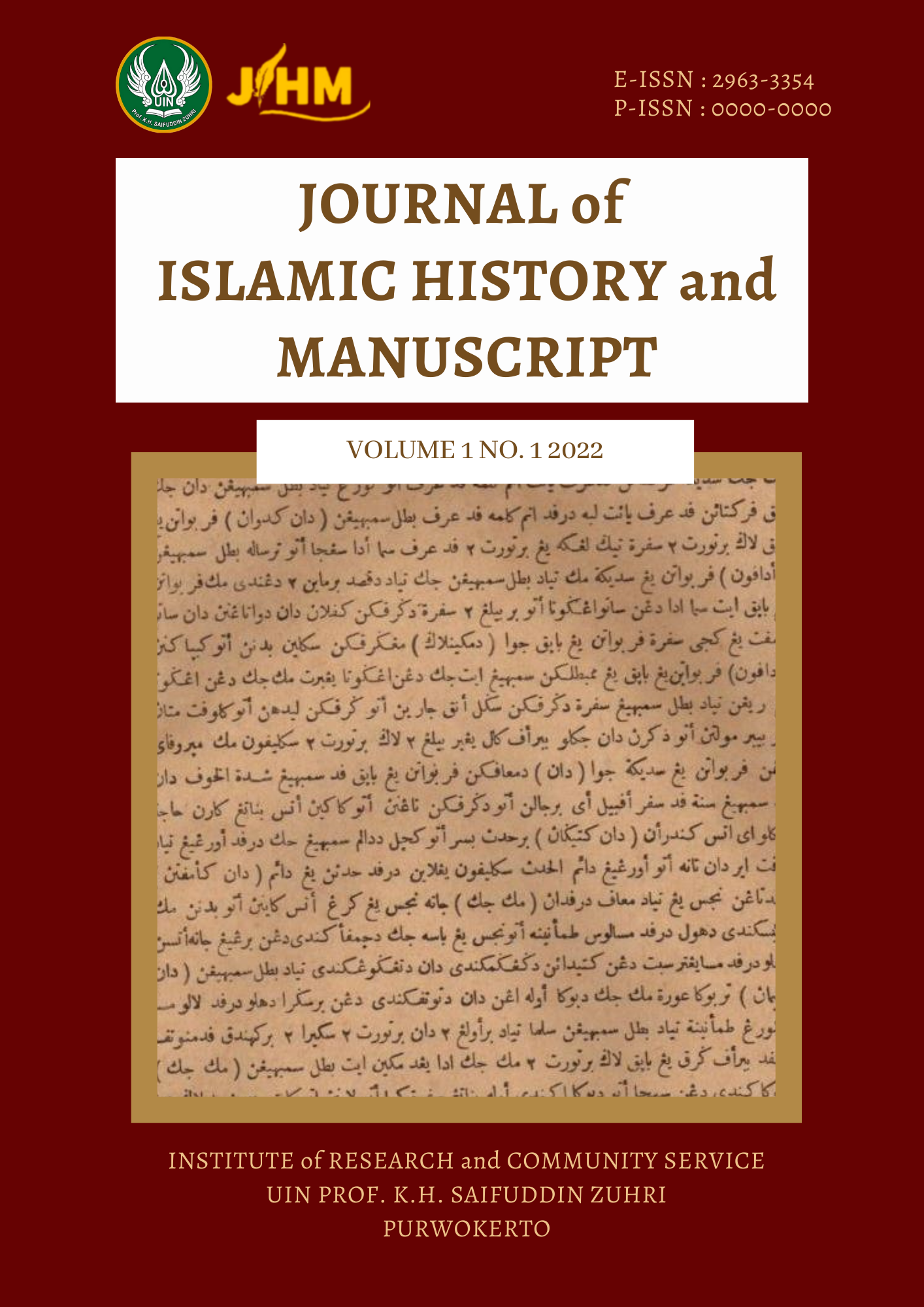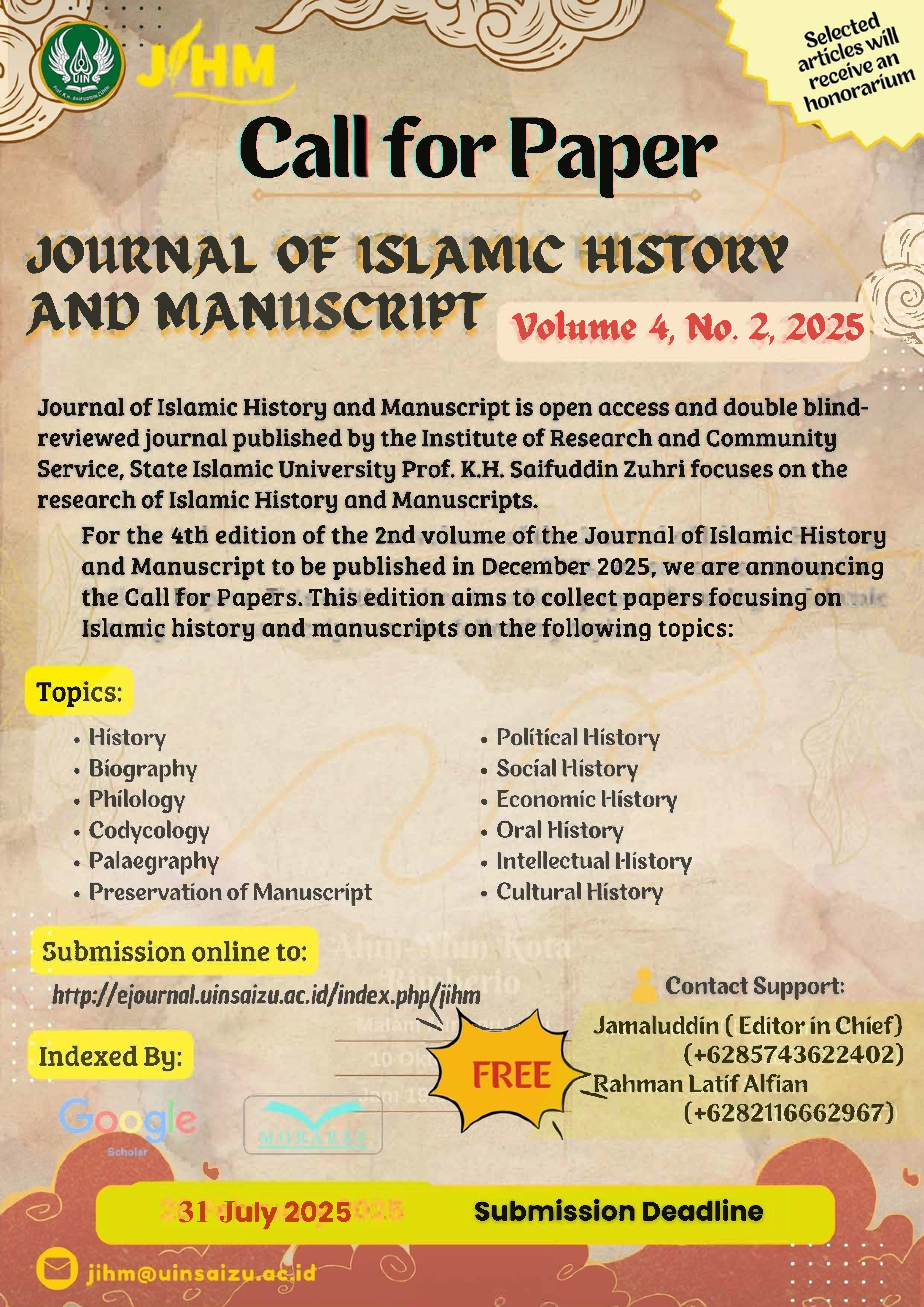God's Punishment for Those Who Leave Prayer (Content Analysis of Nazam Tarikus-Salat in the Book of Aqaid Iman)
DOI:
https://doi.org/10.24090/jihm.v1i1.5696Keywords:
Ancient Script, Nazam Tarikus-Salat, The God's PunishmentAbstract
Nazam Tarikus-Salat (NTS) is a Sundanese Pegon script that belongs to a nadoman or praise poem. NTS is one of the chapters in the text of Aqaid Iman. The research of NTS has two main aims: 1) Producing the clean text edits from reliable copying and writing errors. Moreover, it can be used as a source of research in other fields of science with using manuscripts as the source of information. 2) Describing the religious values contained in NTS in order to give the benefit to the society. To achieve the above aims, it has been applied several theories namely the philology theory and the Quranic intertextuality. The philology theory relates with the text edits. The text editing method used is the standard method, which is to publish the manuscript by correcting small errors. The method used in the research is the method of textual research and the text editing method. The method of the study of the manuscript includes the determination of a single manuscript and a manuscript description. The text editing method in the form of presenting text edits with the critical apparatus without changing its authenticity. The intertextuality used in NTS is more emphasized on the religious values contained in the text. NTS gives an explanation of the God’s punishment for the person who left the salat. By the NTS text, people understand more about the importance of salat because the punishment that will befall people who do not salat is really heavy. In the NTS text, it was described there are fifteen punishments that will be obtained by humans. The punishments are six in the world, three at dead, three in the grave, and three in the Judgment Day.References
Alwi, Hasan. 2001. Kamus Besar Bahasa Indonesia Edsisi ke 3. Balai Pustaka: Jakarta.
Ahmad Fery Nur, Hidayanto. 2015. “Salat dalam Manuskrip Bayan Min al-Furudi Al Wajibat ‘ala Madhab al-Syafi’i Koleksi Museum Mpu Tantular Sidoarjo”. Tesis UIN Sunan Ampel.
An-Nawawi,al-Imam Yahya. 2004. Syarah Hadits Arba’in. Solo: al-Qowam.
Baried, Baroroh dkk. 1994. Pengantar Teori Filologi. Yogyakarta: BPPF UGM.
Djamaris, Edwar. 2002. Metode Penelitian Filologi. Jakarta: CV Manasco.
Djaelani, M Bisri. 2008. Kesempurnaan Salat: Menghadirkan Hati dan Kekusyukan. Yogyakarta: Santusa Printing.
Edaswara, Suwardi. 2002. Metode Penelitian Sastra.Yogyakarta: CAPS.
Ibrahim, M. Kasir. 2005. Kamus Arab. Surabaya: Apollo.
Jalaludin, Rakhmat. 2004. Psikologi Agama Sebuah Pengantar. Bandung: Mizan.
Lubis, Nabilah. 1996. Naskah, Teks dan Metode Penelitian Filologi. Jakarta: Forum Kajian Bahasa dan Sastra Arab Fakultas Adab IAIN Syarif Hidayatullah.
Noor, Redyanto. 2010. Pengantar Pengkajian Sastra. Semarang: FASINDO.
Robson,S. 1994. Prinsip-Prinsip Filologi Indonesia. Jakarta: RUL.
Ruhailah. 2016. Pedoman Ringkasan: Transliterasi, Edisi dan Terjemahan: Aksara Sunda kuna, Buda,Cacarakan dan Pegon. Bandung: JPBD FPBS UPI.
Sjafi’i, Mas’ud. 1967. Pelajaran Tajwid. Semarang : MG.Semarang.
Shuraida, Yana. 2011. “Suntingan Teks dan Makna dalam Kitab Mawaidhotus Salat”. Tesis Universitas Airlangga.
SKB tiga Menteri yaitu Menteri Agama dan Menteri Pendidikan dan Kebudayaan Republik Indonesia tertanggal 22 Januari 1988 No. 158 tahun 1987, No. 0543b/U/1987.
Sunendar, Dadang dkk. 2016. Pedoman Umum Ejaan Bahasa Indonesia. Jakarta: Badan Pengembangan dan Pembinaan Bahasa.
Surono dkk. 2008. Bahasa Indonesia. Semarang: FASINDO.
Suryani, Elis. 2012. Filologi. Bogor: Ghalia Indonesia.
Qordova. 2007. al-Qur’an dan Terjemahan Tipe CA.1. Bandung: Syamil Qur’an.
Yahya. 2004. Syarah Hadits Arbai’in. Solo: al-Qowam.
Zaidan, Abdul Rozak,dkk. 2004. Kamus Istilah Sastra. Jakarta: Balai Pustaka.
Ahmad Fery Nur, Hidayanto. 2015. “Salat dalam Manuskrip Bayan Min al-Furudi Al Wajibat ‘ala Madhab al-Syafi’i Koleksi Museum Mpu Tantular Sidoarjo”. Tesis UIN Sunan Ampel.
An-Nawawi,al-Imam Yahya. 2004. Syarah Hadits Arba’in. Solo: al-Qowam.
Baried, Baroroh dkk. 1994. Pengantar Teori Filologi. Yogyakarta: BPPF UGM.
Djamaris, Edwar. 2002. Metode Penelitian Filologi. Jakarta: CV Manasco.
Djaelani, M Bisri. 2008. Kesempurnaan Salat: Menghadirkan Hati dan Kekusyukan. Yogyakarta: Santusa Printing.
Edaswara, Suwardi. 2002. Metode Penelitian Sastra.Yogyakarta: CAPS.
Ibrahim, M. Kasir. 2005. Kamus Arab. Surabaya: Apollo.
Jalaludin, Rakhmat. 2004. Psikologi Agama Sebuah Pengantar. Bandung: Mizan.
Lubis, Nabilah. 1996. Naskah, Teks dan Metode Penelitian Filologi. Jakarta: Forum Kajian Bahasa dan Sastra Arab Fakultas Adab IAIN Syarif Hidayatullah.
Noor, Redyanto. 2010. Pengantar Pengkajian Sastra. Semarang: FASINDO.
Robson,S. 1994. Prinsip-Prinsip Filologi Indonesia. Jakarta: RUL.
Ruhailah. 2016. Pedoman Ringkasan: Transliterasi, Edisi dan Terjemahan: Aksara Sunda kuna, Buda,Cacarakan dan Pegon. Bandung: JPBD FPBS UPI.
Sjafi’i, Mas’ud. 1967. Pelajaran Tajwid. Semarang : MG.Semarang.
Shuraida, Yana. 2011. “Suntingan Teks dan Makna dalam Kitab Mawaidhotus Salat”. Tesis Universitas Airlangga.
SKB tiga Menteri yaitu Menteri Agama dan Menteri Pendidikan dan Kebudayaan Republik Indonesia tertanggal 22 Januari 1988 No. 158 tahun 1987, No. 0543b/U/1987.
Sunendar, Dadang dkk. 2016. Pedoman Umum Ejaan Bahasa Indonesia. Jakarta: Badan Pengembangan dan Pembinaan Bahasa.
Surono dkk. 2008. Bahasa Indonesia. Semarang: FASINDO.
Suryani, Elis. 2012. Filologi. Bogor: Ghalia Indonesia.
Qordova. 2007. al-Qur’an dan Terjemahan Tipe CA.1. Bandung: Syamil Qur’an.
Yahya. 2004. Syarah Hadits Arbai’in. Solo: al-Qowam.
Zaidan, Abdul Rozak,dkk. 2004. Kamus Istilah Sastra. Jakarta: Balai Pustaka.
Downloads
Published
13-09-2022
How to Cite
Safitri, R. (2022). God’s Punishment for Those Who Leave Prayer (Content Analysis of Nazam Tarikus-Salat in the Book of Aqaid Iman). Journal of Islamic History and Manuscript, 1(1), 69–90. https://doi.org/10.24090/jihm.v1i1.5696
Issue
Section
Articles
License
Authors who publish in this journal agree to the following terms:
- Authors retain copyright and grant the journal right of first publication with the work simultaneously licensed under a Creative Commons Attribution 4.0 International License. that allows others to share the work with an acknowledgment of the work's authorship and initial publication in this journal.
- Authors can enter into separate, additional contractual arrangements for the non-exclusive distribution of the journal's published version of the work (e.g., post it to an institutional repository or publish it in a book), with an acknowledgment of its initial publication in this journal.
- Authors are permitted and encouraged to post their work online (e.g., in institutional repositories or on their website) before and during the submission process, as it can lead to productive exchanges and earlier and greater citation of published work (See The Effect of Open Access).

















